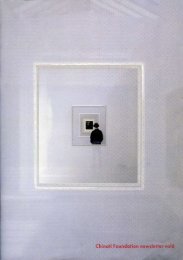Untitled - The Chinati Foundation
Untitled - The Chinati Foundation
Untitled - The Chinati Foundation
Create successful ePaper yourself
Turn your PDF publications into a flip-book with our unique Google optimized e-Paper software.
JOSEF ALBERS, HOMAGE TO THE SQUARE 1958, OIL ON CANVAS.<br />
<strong>The</strong> following essays (1959-1964) were pub-<br />
lished in Donald Judd, Complete Writings, 1959-<br />
1975, <strong>The</strong> Press of the Nova Scotia College of<br />
Art and Design, 1975. <strong>The</strong>y are reprinted here<br />
with permission from Judd <strong>Foundation</strong>.<br />
“IN THE GALLERIES”<br />
ARTS MAGAZINE,<br />
DECEMBER 1959<br />
Josef Albers: <strong>The</strong> continued expansion<br />
of this lambent geometry is<br />
very impressive. One of the numerous<br />
“Homage to the Square” series,<br />
Luminant, elucidates the similar subtlety<br />
of the rest. This painting is the<br />
typical four circumjacent squares offset<br />
to the lower edge. <strong>The</strong> color of the<br />
central orange square, fairly intense<br />
and slightly red, glows and expands<br />
into the next, light-cadmium-orange<br />
on<br />
Donald Judd Josef Albers<br />
Los ensayos siguientes (1959-1964) se publica-<br />
ron en Donald Judd, Complete Writings, 1959-<br />
1975, <strong>The</strong> Press of Nova Scotia College of Art and<br />
Design, 1975. Se reproducen acquí con permiso<br />
de la Fundación Judd.<br />
“ E N L A S G A L E R Í A S ”<br />
A RT S M A G A Z I N E ,<br />
D I C I E M B R E D E 1 9 5 9<br />
Josef Albers: La expansión continua de<br />
esta geometría refulgente es muy impre-<br />
sionante. Una de las numerosas series<br />
“Homenaje al cuadrado”, Luminant, elu-<br />
cida la sutileza similar de las demás. En<br />
esta pintura vemos los acostumbrados<br />
cuadrados circunyacentes en la parte<br />
inferior del lienzo. El color del cuadra-<br />
do anaranjado central, bastante inten-<br />
so y algo rojizo, brilla con luz difusa y<br />
se expande, penetrando en el cuadro<br />
sobre<br />
57<br />
square, which in turn, but with declining<br />
strength, influences a square<br />
somewhere between raw sienna and<br />
yellow ocher. An outer medium-gray<br />
square contrasts immensely with the<br />
warm ones and contains them. <strong>The</strong><br />
unbounded color and the final disparity<br />
belie the apparent rigidity of<br />
the geometry and provide the central<br />
lyric and exultant ambiguity of the<br />
painting. Further—because of the<br />
low position of the squares on the<br />
canvas—the bands at the top, the bot-<br />
tom and the two sides vary—which<br />
allows the complex development of<br />
a hierarchy of scale and a range of<br />
close colors and values. <strong>The</strong> proximity<br />
and the extent of a color change<br />
the scale of an area, the type of contrast<br />
and the color itself. <strong>The</strong> work is<br />
exceptionally intriguing and presents<br />
a conception of multiple distinctions<br />
within a single context, itself in turn<br />
manifold. Another painting of the series,<br />
In and Out—which it is—is viridian<br />
and gray, a handsome combination,<br />
but the two outer bands each<br />
contain both light and dark gray mitered<br />
at the corners which produces<br />
a recession and a frontality that wobbles,<br />
never becoming stable. Many<br />
of the colors are scraped slightly to<br />
expose the white ground; this adds a<br />
luminosity superior to that of the earlier<br />
works, as well as implying various<br />
textures. Most of the paintings<br />
siguiente, de color anaranjado cadmio<br />
claro, el cual influye a su vez, aunque<br />
en menor grado, un cuadrado entre<br />
siena y ocre amarillo. Un cuadrado ex-<br />
terior gris contrasta notablemente con<br />
los más cálidos y los contiene. El color<br />
sin fronteras y la disparidad desmien-<br />
ten la aparente rigidez de la geometría<br />
y crean la ambigüedad central lírica y<br />
regocijada de la obra. Además, dada la<br />
posición baja de los cuadrados sobre el<br />
lienzo, las bandas en la parte superior<br />
e inferior y los dos lados varían, lo que<br />
permite el desarrollo complejo de una<br />
jerarquía de escalas y tonos y valores<br />
de color ligeramente distintos. La proxi-<br />
midad y el grado de un color modifican<br />
la escala de un área, el tipo de contras-<br />
te y el color mismo. Esta obra es excep-<br />
cionalmente fascinante y presenta una<br />
concepción de distinciones múltiples<br />
dentro de un solo contexto, el cual es,<br />
a su vez, múltiple. Otra pintura de esta<br />
serie, In and Out—un buen título—es<br />
verde viridiano y gris, una bella combi-<br />
nación, pero ambas bandas exteriores<br />
contienen gris claro y oscuro en inglete<br />
en las esquinas, produciendo un efecto<br />
de regresión y frontalidad en movimien-<br />
to, nunca estable. Muchos de los colores<br />
han sido raspados ligeramente para<br />
dejar ver el fondo blanco, con lo que se<br />
consigue una luminosidad superior a la<br />
de las obras anteriores, además de la<br />
sugerencia de varias texturas. La mayo-<br />
ría de las pinturas son de la misma alta<br />
STUDY FOR HOMAGE TO THE SQUARE, HIGH SPRING, 1962, OIL ON CANVAS.






